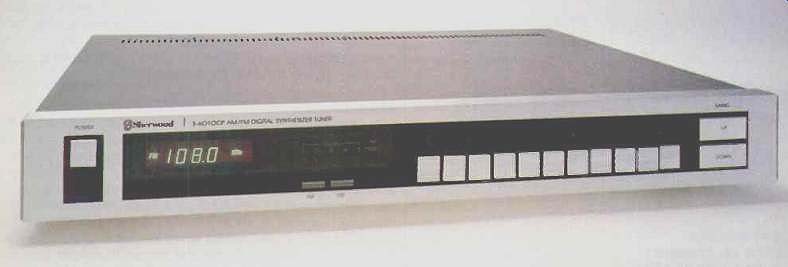
Manufacturer's Specifications
FM Section:
Usable Sensitivity: Mono, 10.3 dBf.
50-dB Quieting Sensitivity: Stereo, 36.5 dBf.
S/N: Mono, 80 dB; stereo, 75 dB.
Alternate Channel Selectivity: 80 dB.
Capture Ratio: 1.0 dB.
THD: Mono, 0.09%; stereo, 0 09%.
AM Section:
Sensitivity: 200 µV/meter (bar antenna).
S/N: 45 dB. Selectivity: 55 dB.
General Specifications:
Power Consumption: 10 to 12 watts.
Dimensions: 17 3/8 in. (44 cm) W x 2 1/4 in. (5.5 cm) H x 15 1/2 in. (35 cm) D.
Weight: 10 3/8 lbs. (4.7 kg).
Price: $249.95.
Company Address: Div. of Inkel Corp., 17107 Kingsview Ave., Carson, Cal. 90746.
How times change! Over the years I have watched the fortunes and rank of Sherwood alternate between being a top-flight component manufacturer and an almost forgotten pioneer in the field. However, whatever their position in the scheme of things, it does seem reasonable and fitting that Sherwood should at this time come up with as fine an FM/AM tuner as they have in this very moderately priced gem of a frequency-synthesized unit.
If you are a long-time reader of Audio, you probably remember when Sherwood introduced (and we tested) a tuner called the Micro/CPU-100. It had been designed by Larry Schotz, the same gentleman who designed the recently reviewed NAD 4150 tuner, about which we had so many good things to say. But that early Sherwood unit (it was way ahead of its time, technically speaking as well as in its performance capabilities) cost over $2,000! The new unit, at not much more than one-tenth that price, does not, of course, have all the features of the early Sherwood masterpiece, but its performance leaves very little to be desired. Certainly, the S-6010CP is worthy of the venerable Sherwood name.
The low-profile front panel houses a power switch at the extreme left, FM and AM selector buttons, eight station preset buttons (with which you can "memorize" the frequencies of eight favorite FM plus eight AM stations for instant recall), a memory button for "storing" those frequencies, an FM mute/mode switch which combines interstation noise reduction with stereo operation in one position and no noise reduction with mono in the other, an "Auto/Manual" switch, and "Up" and "Down" tuning buttons. When the "Auto/ Manual" switch is set to "Auto," the tuning buttons cause the tuner to seek out the next usable signal on the dial.
When the "Manual" mode is used, depressing the "Up" or "Down" buttons advances the tuning (either higher or lower) by 100-kHz increments.
A fluorescent display occupies the left section of the panel and shows tuned-to frequency, while signal-strength LED indicators, calibrated in five steps, and a stereo indicator light are located nearby.
The rear panel of the Sherwood S-6010CP has provisions for connecting either a 75-ohm coaxial antenna cable or the flat, twin-lead 300-ohm type of transmission line. A rotatable AM bar antenna is also provided, and if it is inadequate in your listening area, there are terminals for connecting an outdoor AM antenna.
Circuit Highlights
The tuner circuitry is contained on three well-designed p.c. boards. The major board contains all of the basic AM and FM/stereo circuitry, while the remaining two boards carry components relating to the fluorescent display and other front-panel functions. The r.f. amplifier in the front-end employs a dual-gate MOS-FET and a four-section varactor tuning system. The i.f. section employs three pairs of linear phase ceramic filters and a double-tuned, quadrature FM detector. A PLL multiplex demodulator with 19- and 38-kHz filters decodes the composite stereo FM signal.
While an FET r.f. amplifier is used in the AM section, the rest of the circuitry is rather minimal (as with most "hi-fi" AM/ FM tuners), employing a two-section varactor tuning system and a single wideband ceramic filter.
Here's an unusual twist! A lithium battery is supplied inside the S-6010CP as a backup for the memorized preset station frequencies. And--are you ready for this?--in case of a power failure or if you unplug the set when leaving for a vacation, the battery will keep your favorite frequencies memorized for at least 10 years! (Who has such long vacations--or power failures, for that matter?)
Measurements
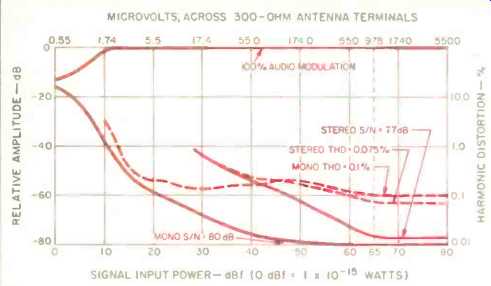
Fig. 1--Mono and stereo FM quieting and distortion characteristics.
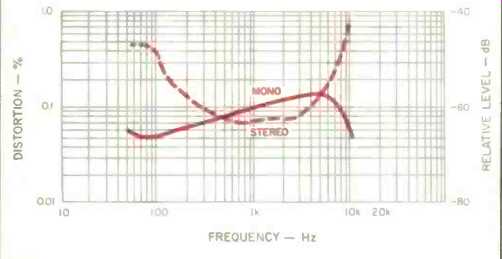
Fig. 2--Harmonic distortion vs. frequency, FM section, with 15-kHz bandpass
in measurement circuits.
I measured a monophonic usable sensitivity of 10.0 dBf (1.7 µV across the 300-ohm input), an impressive figure for such a low-cost tuner. The 50-dB quieting point in mono was reached with a signal strength of only 12.7 dBf (2.4 µV across 300 ohms), while in stereo the 50-dB quieting signal requirement was 37 dBf (38.9 µV across 300 ohms). Muting threshold was set at about 29 dBf (15.5 µV), and since the muting feature always works when the tuner is in the stereo mode, this determined both the stereo threshold and the effective usable stereo sensitivity. By the time the stereo signal causes the tuner to switch to the stereo mode, quieting is already a respectable 44.0 dB, and distortion at that low signal strength is already down to only 0.7%. Increasing the signal strength to the nominal level of 65 dBf, S/N in mono reached a very fine 80 dB. In stereo, S/N measured 77 dB, better than the manufacturer's claim by 2 dB. These results are plotted in Fig. 1 as a function of signal input level, along with distortion curves for mid-frequency, 100% modulating signals. Figure 2 shows how harmonic distortion varies with frequency, for both the mono and stereo receiving modes. At mid-frequencies, THD in mono was 0.1%, just slightly poorer than claimed, but in stereo harmonic distortion was actually better than claimed, measuring only 0.075%. Distortion remained low at the other test frequencies of 100 Hz and 6 kHz. In stereo, where "beats" usually contribute to the "distortion" reading (they're not, strictly speaking, harmonic distortion, but they certainly are audible), this tuner still gave a reading of only 0.19% of combined THD + beats.
Frequency response, with the tuner operating in the stereo mode, is plotted as the upper curve in the spectrum analysis photo of Fig. 3. The plot extends from 20 Hz to 20 kHz (logarithmically swept), and vertical sensitivity of the display is the usual 10 dB per division. Maximum measured deviation from "flat" response in the range from 30 Hz to 15 kHz was never more than +0.4 dB (at 5 kHz) or-0.5 dB (at 30 Hz). The lower curve in Fig. 3 is the plot of crosstalk, or stereo separation. Notice how uniform the separation is even at the frequency extremes, as opposed to the "concave" separation curve we usually see for most low-cost tuners. Separation was between 42 and 45 dB (depending upon the channel measured) at 1 kHz, between 43 and 45 dB at 100 Hz, and a perfectly aligned 38 dB at 10 kHz on both channels (right-to-left or left-to-right). Figure 4 analyzes crosstalk distortion products for a 5 kHz modulating signal. In this 'scope photo, frequencies are now linearly displayed (5 kHz per horizontal division), from d.c. to 50 kHz. The two spikes at the left (one within the other) represent the "desired" and "undesired" 5-kHz output signals from the two tuner channels. Notice how low in amplitude the other "spikes" at harmonics of 5 kHz and at subcarrier frequencies are; that's the result of the excellent subcarrier (19 and 38 kHz) filtering in this tuner's multiplex decoding circuits. I measured subcarrier rejection of better than 74 dB and SCA rejection of better than 75 dB. Such numbers are rarely, if ever, obtained from any tuner, regardless of its price.
Capture ratio was a bit over 1.0 dB. Selectivity measured a very satisfactory 79 dB, while AM suppression was in excess of 60 dB. Image, i.f. and spurious response rejection all hovered around the 90 dB mark.
Figure 5 is the usual disappointing presentation of the tuner's AM frequency-response characteristics. Response is falling fast, above 2.0 kHz, and I won't belabor the point any further!
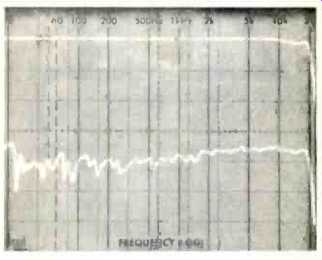
Fig. 3--FM frequency response (upper trace) and stereo separation vs.
frequency (lower trace).
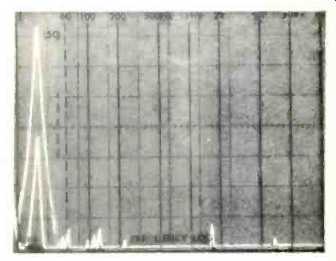
Fig. 4--Analysis of 5-kHz separation and crosstalk.
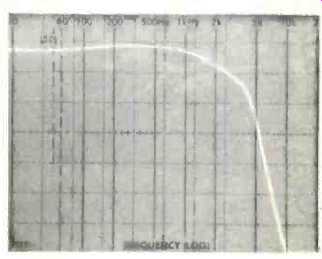
Fig. 5--Frequency response, AM section.
Use and Listening Tests
The Sherwood S-6010CP is a real "sleeper" of a tuner! It tunes simply and easily and, of course, there's absolutely no detectable drift, as with all frequency-synthesized tuners. It pulled in fully as many stations with acceptable listening quality as tuners costing two and three times as much, and I would strongly urge you to use a directional antenna with this tuner to avoid multipath problems and other forms of interference. Frequency allocations in this country have simply not kept up with tuner and receiver technology, so it's not unusual for a tuner such as this to actually be "too good" for certain FM signal environments. Again, a good outdoor directional antenna (with a rotator, if needed in your area) can help tremendously here, since you can "block" offending interfering signals by pointing the antenna away from them.
There are only a very few situations in which an FM listener would require a better tuner than this one, considering the state of affairs in the band of frequencies between 88 and 108 MHz. I for one am glad to see Sherwood back with the quality of product which earned the original Sherwood Laboratories their great reputation in the '60s and '70s. Welcome to the '80s, Sherwood!
--Leonard Feldman
(Audio magazine, Apr. 1983)
Also see:
Sherwood Model Micro/CPU 100 Stereo FM Tuner (Nov. 1977)
Sherwood S-2680CP Receiver (June 1984)
= = = =